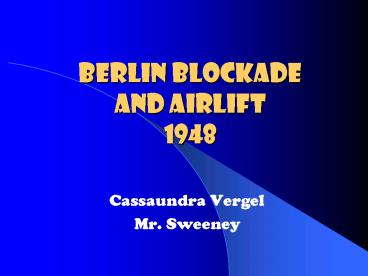Berlin Blockade and Airlift 1948 - PowerPoint PPT Presentation
1 / 9
Title:
Berlin Blockade and Airlift 1948
Description:
May 8 Berlin is divided into four sectors: American, British, French, and USSR. June 23 Currency is reformed in Berlin. Berlin is divided into two currency zones. ... – PowerPoint PPT presentation
Number of Views:82
Avg rating:3.0/5.0
Title: Berlin Blockade and Airlift 1948
1
Berlin Blockade and Airlift 1948
- Cassaundra Vergel
- Mr. Sweeney
2
Timeline
- 1945
- February - Yalta Conference
- May 8 Berlin is divided into four sectors
American, British, French, and USSR. - June 23 Currency is reformed in Berlin. Berlin
is divided into two currency zones. - July August Potsdam Conference.
- 1948
- March 20 - Soviets leave Allied Commission
Control. - June 24 Berlin Blockade begins for 11 months.
- June 25 Airlift begins.
- 1949
- May Soviet opens Berlin.
- September 30 Airlift officially ends.
3
What is it?
The Berlin blockade and airlift were vital events
of WWII. The main aim of the Berlin Blockade was
for the Soviets to keep the Allies out of Berlin,
a major city in Eastern Germany.
Operation Vittles (Feltus)
Children waving to U.S. soldiers dropping food
supplies, such as candy. (Enterprise)
4
At the Yalta conference of February 1945 an
agreement was made between Truman and Stalin to
divide Germany between four countries France,
Great Britain, the U.S., and the U.S.S.R.
However, access to Berlin, which was also split
between the four countries, was not discussed.
Stalin, fearing domination of Germany by the
western allies, blocked off all railways and
roads leading into and out of Berlin, allowing
him complete control over the city.
Churchill, Truman, and Stalin (The Potsdam)
5
The main reason for the blockade could be defined
as part of the great power strategic
considerations. After the Potsdam Conference the
two countries disagreed over the Soviets control
over Eastern Europe. Stalin believed that by
forcing the Allies out of a major city such as
Berlin, it would make the city completely
dependent on the U.S.S.R. He now had control over
a population of more than 2,500,000 people
starving and cold.
Up to 102 of these C-47s were flying during the
first three months of the Berlin Airlift. (Feltus)
6
The Allies solution to this problem was the
Berlin Airlift beginning June 25, also known as
Operation Vittles. Under the leadership of
General Curtis LeMay, 5,000 tons of food, coal,
and supplies were dropped from planes over the
city of Berlin. Ten-ton capacity C-54's flew day
and night for more than eleven months. The
operation, nicknamed LeMays feed and coal
company, was especially important in the winter
when temperatures dropped and no coal was
transported into the country.
Loading a plane with milk. (Berlin Airlift)
7
After number attempts, the Soviets could not
relent the Allies operation and finally in May
1949, the Soviets agreed to end the blockade and
for the first time in 320 days, vehicles were
allowed to pass through to the city. However, the
operation officially ended on September 30, 1949
after 2.3 million tons of cargo and 277,685
flights.
Loading supplies into the plane. (Feltus)
8
Quiz Questions
1.) What aspect does the Berlin blockade and
airlift illustrate in the Cold war? How? 2.) Why
was the Berlin Airlift an effective solution to
the blockade?
9
Bibliography
- Berlin Airlift Website, U.S. Air Forces in
Europe, USAFE Public Affairs, August 14, 2000. - http//www.usafe.af.mil/berlin/photos.htm
- Enterprise, UPI/Corbis-Bettmann
- http//www.shearman.com/enterprise/airlift.html
- Feltus, Pamela, The Berlin Airlift, U.S.
Centennial of Flight Commission, - http//www.centennialofflight.gov/essay/Air_Power/
berlin_airlift/AP35.htm - The Potsdam Conference, National Atomic Museum,
2003. - http//www.atomicmuseum.com/tour/photos/churchill_
stalin_truman_potsdam.jpg































